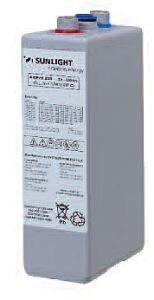|
Quantity
|
Out of stock
|
||
|
|
|||
OPzV batteries are characterized by long life, high durability under cyclic conditions of use, as well as due to their low maintenance requirements, provide a cost-effective solution.
Their optimal design (in accordance with international standards DIN) and the strength of the battery makes OPzV ideal solution for demanding applications such as alternative energy and telecommunication systems
The use of:. < br /> - Telecommunication systems
- system monitoring and management of power plants and power stations
- signaling systems at stations, airports and ports
- emergency lighting systems
- processing systems data
- Uninterruptible power supply (UPS)
- Alternative energy systems (solar, wind, hydro)
- automation systems
Features and benefits:
- Capacities exceed the nominal values of international standards DIN
- Long service life (18 years at 20 ° C)
- Excellent condition with cyclic applications and deep discharge
- High energy efficiency and reliability
- Increased uro Safety Wen
- maintenance free (not require the addition of water or electrolyte)
- Maximum compatibility
- may be installed in any orientation (vertical and horizontal, except reverse)
- recyclable
specifications:
capacity a / h, C10 (1.8 V / cell, 20 ° C.) - 213
capacity plate a / h, C10 (1 ., 8 V / e, 20 ° C) - 50 number of plates
(+) to the element - 4
nominal voltage of the cell, V - 2
number of poles - 2 current
short circuit, A - 2010
The voltage buffer mode V / cell. - 2.25
maximum charging current of 0.4 A C10 - 80
recommended fast charge voltage, V / cell. - 2,35
Recommended discharge voltage for 10 h mode V / cell. - 1,8
Recommended discharge voltage for 1 hour mode, B / E. - 1,65
Internal resistance mOhm / cell. - 1.02
efficiency factor, kWh - 85%
Factor efficiency Ah - 95%
length, mm - 103
Width - 206
height, mm - 382
Weight - 20
terminals Type - M10
Structure:
Positive electrode - a tubular plate with a corrosion resistant alloy PbCaSn (lead-calcium alloy);
Negative electrode - in the alloy grid plate PbCaSn;
separator - micropore;
electrolyte - sulfuric acid density of 1.24 g / cm3 by pyrogenic silicic acid is linked into a gel;
housing and cover - impact resistant ABS (acrylonitrile-styrene-butanodien) gray dyeing;
valve - one-way valve with protection against reverse ignition open at a pressure of 120 mbar;
pole Born - 100% impermeable to gas and electrolyte, under bolt M10;
connector (jumper) - flexible insulated copper cables with cross-sections 25, 35, 50, 70, 95 or 120 mm2
charging characteristics:
current charge -. Imax is not limited ;
charging voltage - U = 2,23 V / cell ± 1%, at temperatures ranging from 10 ° C to 30 ° C;
temperature coefficient - delta U / deltaT = -0.003 In / ° C with average temperatures below 10 ° C;
current in the charging mode, - about 15 mA to 100 Ah to 30 Ah 100 mA to an end life;
charge high voltage - U = 2,33 - 2, 40 V / cell, is limited in time;
charging time to 90% - 6h at an initial current 1,5 x I10, the voltage 2.23 V / cell (at 50% discharge of C10)
<. br /> Discharge characteristics:
recommended temperature - 20 ° C;
Initial capacity - 95% for 1 cycle; 100% for 5 cycles;
discharge rate - usually 80%;
Deep discharge - to avoid a discharge rate greater than 80% and lower discharge end of the discharge voltages
Maintenance:.
Every 6 months - check the battery voltage, voltage and temperature control elements;
Every 12 months - to bring the battery voltage protocol, cell voltage and temperature
Features of operation:.
lifetime - 18 years at temperatures ranging from 20 ° C to 25 ° C;
Service - during the life of water refilling is not required;
Number of cycles - more than 1650 (at 60% DOD );
The self - less than 2% per month at 20 ° C;
operating temperature - -20 ° C to 55 ° C, is recommended from 10 ° C to 30 ° C
.

